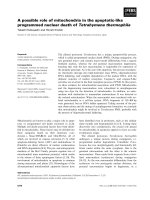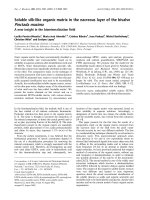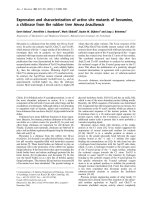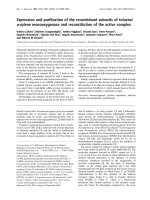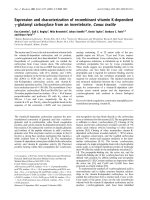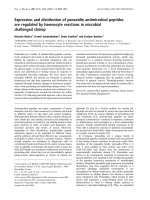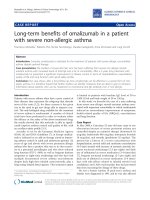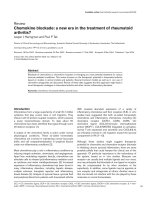Báo cáo y học: "Expression and regulation of neurotrophins in the nondegenerate and degenerate human intervertebral disc" pdf
Bạn đang xem bản rút gọn của tài liệu. Xem và tải ngay bản đầy đủ của tài liệu tại đây (3.2 MB, 9 trang )
Open Access
Available online />Page 1 of 9
(page number not for citation purposes)
Vol 10 No 4
Research article
Expression and regulation of neurotrophins in the nondegenerate
and degenerate human intervertebral disc
Devina Purmessur, Anthony J Freemont and Judith A Hoyland
Tissue, Injury and Repair, School of Clinical and Laboratory Sciences, Faculty of Medical and Human Sciences, Stopford Building, Oxford Road, The
University of Manchester, Manchester, M13 9PT, UK
Corresponding author: Judith A Hoyland,
Received: 10 Jun 2008 Revisions requested: 11 Jul 2008 Revisions received: 23 Jul 2008 Accepted: 27 Aug 2008 Published: 27 Aug 2008
Arthritis Research & Therapy 2008, 10:R99 (doi:10.1186/ar2487)
This article is online at: />© 2008 Purmessur et al.; licensee BioMed Central Ltd.
This is an open access article distributed under the terms of the Creative Commons Attribution License ( />),
which permits unrestricted use, distribution, and reproduction in any medium, provided the original work is properly cited.
Abstract
Introduction The neurotrophins nerve growth factor (NGF) and
brain-derived neurotrophic factor (BDNF) have been identified in
the human intervertebral disc (IVD) and have been implicated in
the mechanisms associated with nerve ingrowth and
nociception in degeneration of the IVD. The aim of the current
study was to investigate an association between neurotrophin
expression in the IVD and the severity of disc degeneration,
including the effect of disc-related proinflammatory cytokines on
neurotrophin and neuropeptide expression in cells derived from
the human IVD.
Methods Immunohistochemical analysis was performed to
examine the expression of NGF, BDNF and their high-affinity
receptors Trk-A and Trk-B in human IVD samples, divided into
three categories: non-degenerate, moderate degeneration and
severe degeneration. In order to study the effect of disc-related
cytokines on neurotrophin/neuropeptide gene expression,
nucleus pulposus cells derived from non-degenerate and
degenerate IVD samples were seeded in alginate and were
stimulated with either IL-1β or TNFα for 48 hours. RNA was
extracted, cDNA was synthesised and quantitative real-time
PCR was performed to examine the expression of NGF, BDNF
and substance P.
Results Immunohistochemistry showed expression of NGF and
BDNF in the native chondrocyte-like cells in all regions of the
IVD and in all grades of degeneration. Interestingly only BDNF
significantly increased with the severity of degeneration (P <
0.05). Similar expression was observed for Trk-A and Trk-B,
although no association with disease severity was
demonstrated. In cultured human nucleus pulposus cells,
stimulation with IL-1β led to significant increases in NGF and
BDNF gene expression (P < 0.05). Treatment with TNFα was
associated with an upregulation of substance P expression only.
Conclusion Our findings show that both the annulus fibrosus
and nucleus pulposus cells of the IVD express the neurotrophins
NGF and BDNF, factors that may influence and enhance
innervation and pain in the degenerate IVD. Expression of Trk-A
and Trk-B by cells of the nondegenerate and degenerate IVD
suggests an autocrine role for neurotrophins in regulation of disc
cell biology. Furthermore, modulation of neurotrophin
expression by IL-1β and modulation of substance P expression
by TNFα, coupled with their increased expression in the
degenerate IVD, highlights novel roles for these cytokines in
regulating nerve ingrowth in the degenerate IVD and associated
back pain.
Introduction
Low back pain is a widespread and incapacitating disorder of
significant social and economic importance [1]. Degeneration
of the intervertebral disc (IVD) has been implicated in the
pathogenesis of chronic low back pain [2], and is character-
ised by increased degradation of the extracellular matrix cou-
pled with an ingrowth of blood vessels and nerves [3,4] into
the normally avascular and aneural tissue. Indeed, we have
shown an association between the painful degenerate IVD and
nerve ingrowth [5]. The mechanisms underlying innervation
into the degenerate human IVD, however, are largely unknown.
Studies by Johnson and colleagues have demonstrated that
the extracellular matrix component aggrecan, derived from the
healthy IVD, has an inhibitory effect on neurite outgrowth [6].
Likewise, such an inhibitory effect has also been demonstrated
in an ovine annular model of disc degeneration in which
BDNF = brain-derived neurotrophic factor; DMEM = Dulbecco's modified Eagle's media; FCS = foetal calf serum; IAF = inner annulus fibrosus; IL =
interleukin; IVD = intervertebral disc; NGF = nerve growth factor; NP = nucleus pulposus; OAF = outer annulus fibrosus; PBS = phosphate-buffered
saline; PCR = polymerase chain reaction; TNF = tumour necrosis factor.
Arthritis Research & Therapy Vol 10 No 4 Purmessur et al.
Page 2 of 9
(page number not for citation purposes)
depletion of the proteoglycan content was associated with an
increased nerve ingrowth into the IVD [7].
The normal healthy IVD is largely aneural. Anatomical studies
by Jackson and colleagues and by Bogduk and colleagues
have demonstrated innervation of only the superficial outer lay-
ers of the annulus fibrosus, with the central core of the IVD
completely lacking nerves [8,9]. This is supported by the work
of Fagan and colleagues, who have demonstrated innervation
of both the perianular region of the IVD as well as the central
region of endplate above the nucleus pulposus (NP) [10].
Within the degenerate IVD, however, nerves have been shown
to penetrate both the inner annulus fibrosus (IAF) and the NP.
Importantly, these innervating fibres have been shown to
express both the neural growth-associated marker GAP43
and the pain-associated neuropeptide substance P [5].
Additional studies investigating innervation in the degenerate
IVD have also demonstrated expression of Trk-A, the high-
affinity receptor for nerve growth factor (NGF), on ingrowing
nerves – indicating that such nerves are NGF sensitive [4].
This is supported by Aoki and colleagues, who have identified
NGF-responsive nerve fibres as the predominant neuronal
subtype innervating the peripheral regions of the healthy annu-
lus fibrosus [11]. Studies by Ohtori and colleagues have also
demonstrated that a number of the neurons innervating the rat
IVD were immunoreactive for brain-derived neurotrophic factor
(BDNF), a modulator of pain-associated processes in the dor-
sal horn of the spinal cord [12].
Neurotrophins are growth and survival factors, associated
mainly with neuronal development, function and nociception
[13]. They are located primarily within the central and periph-
eral nervous systems, and they consist of a family of four prin-
cipal members: NGF, BDNF, neurotrophin 3 and neurotrophin
4/5. Both NGF and BDNF have been identified in non-neural
cells of healthy and diseased connective tissue such as human
cartilage and bone, and, interestingly, recent studies have
highlighted a possible role for neurotrophins in the IVD [14-
17]. For example, Johnson and colleagues demonstrated stim-
ulation of neurite outgrowth by soluble mediators produced by
degenerate disc cells, mediators they hypothesised to be neu-
rotrophic factors [18]. Additionally, NGF has been identified in
association with the blood vessels growing into the degener-
ate IVD [4], and also in the rounded chondrocyte cells of the
annulus fibrosus [16]. More recently, Abe and colleagues have
confirmed this and have also shown both expression and syn-
thesis of NGF in NP cells isolated from the human IVD [19].
As well as NGF expression, microarray analysis of human disc
cells subjected to hyperosmotic stimuli has identified expres-
sion and upregulation of BDNF [20]. Additionally, in a recent
study Gruber and colleagues showed expression of BDNF in
human IVD cells, with BDNF gene expression in annulus fibro-
sus cells positively correlating with increasing degeneration
[21]. Whether both NGF and BDNF are upregulated in the
degenerate IVD, and as such play a key role in innervation and
the pathogenesis of low back pain, however, remains to be
determined.
The neurotrophins NGF and BDNF function principally
through their high-affinity receptors Trk-A and Trk-B. Indeed,
both receptors have been identified in cells of the muscu-
loskeletal system, and more recent studies have demonstrated
Trk-A and Trk-B expression in human disc cells [14-17,19,21].
Studies investigating a role for neurotrophins in the pathogen-
esis of osteoarthritis have shown upregulation of both NGF
and Trk-A in osteoarthritic chondrocytes [15]. Nevertheless,
expression of Trk-A and Trk-B by human disc cells in terms of
disease pathology has yet to be fully examined.
A role for the proinflammatory cytokines TNFα and IL-1β in
innervation of the IVD [22] and in degeneration of the IVD has
been demonstrated by a number of authors [23-25]. Addition-
ally these cytokines have been shown to regulate neurotrophin
expression in non-neuronal cells. Studies by Kemi and col-
leagues have demonstrated upregulation of NGF and BDNF in
bronchial smooth muscle cells after treatment with IL-1 [26].
Similarly, in synovial fibroblasts isolated from patients with
osteoarthritis, both IL-1β and TNFα were shown to increase
NGF synthesis and release [27]. Evidence to support a role for
IL-1β and TNFα in the modulation of neurotrophin expression
in the IVD comes from studies by Abe and colleagues, who
demonstrated an increase in NGF gene expression and pro-
tein secretion after NP cells (cultured in monolayer) were
treated with IL-1β and TNFα [19].
Work to date therefore supports a role for neurotrophins in the
biology of innervation in the IVD, the function of which may be
regulated by proinflammatory cytokines known to be upregu-
lated during IVD degeneration [23-25]. Based on this knowl-
edge we hypothesised that expression of the neurotrophins
NGF and BDNF increases with disc degeneration and that
they are regulated by IL-1β, which also increases with the
severity of degeneration. Using immunohistochemistry we
have therefore investigated NGF and BDNF expression,
including expression of the receptors Trk-A and Trk-B, in non-
degenerate, moderately degenerate and severely degenerate
human IVD tissue, and we have examined the effects of IL-1β
and TNFα on neurotrophin expression in non-degenerate and
degenerate disc cells (seeded in a three-dimensional matrix).
Materials and methods
NGF, BDNF, Trk-A and Trk-B protein expression in the
nondegenerate and degenerate human IVD
Human IVD tissue was obtained at surgery/postmortem, and
ethical consent was obtained from the local ethical commit-
tees together with informed consent from the patient or rela-
tives. IVD tissue samples were fixed overnight in 4%
Available online />Page 3 of 9
(page number not for citation purposes)
paraformaldehyde/PBS at 4°C, processed to paraffin wax and
5 μm sections prepared.
For immunohistochemical analysis, a total of 15 patient sam-
ples were used (age range 37 to 75 years): non-degenerate
IVDs (grades 1 to 4), moderately degenerate IVDs (grades 5
to 8) and severely degenerate IVDs (grades 9 to 12), with five
patient samples per category. Grading of IVD tissue was car-
ried out as described by Sive and colleagues [28].
Immunohistochemical procedure
The immunohistochemical protocol was as previously pub-
lished [20]. Briefly, following blocking of endogenous peroxi-
dase and antigen retrieval with chymotrypsin (1% w/v) at 37°C
for 20 minutes, sections were incubated overnight at 4°C with
either 15 μg/ml primary goat anti-NGF, 15 μg/ml primary
mouse anti-BDNF, 10 μg/ml primary goat anti-Trk-A or 8 μg/
ml primary mouse anti-Trk-B antibodies (R&D Systems, Abing-
don, UK). Negative controls were used in which respective
goat and mouse IgGs (R&D Systems) replaced the primary
antibody. After washing, sections were incubated with bioti-
nylated donkey anti-goat and goat anti-mouse secondary anti-
bodies (Santa Cruz, CA, USA) at dilutions of 1/300 and 1/
400, respectively, for 30 minutes at room temperature. Disclo-
sure of secondary antibody binding was by the streptavi-
din–biotin complex (Dako, Cambridgeshire, UK) technique
with 3,3'-diaminobenzidine tetrahydrochloride solution
(Sigma, Poole, UK). Sections were counterstained with May-
ers Haematoxylin (Raymond. A. Lamb, East Sussex, UK), were
dehydrated and were mounted in XAM (BDH, Liverpool, UK).
Analysis of immunohistochemical data
For each tissue section, the different regions of the disc – NP,
IAF and outer annulus fibrosus (OAF) – were first identified
based on the cell morphology and the structure of the extracel-
lular matrix. Up to a total of 400 cells were counted in each
region of the IVD, and the number of positively stained cells
was expressed as a percentage of the total number.
Statistical analysis
All data were tested for normality using the Shapiro–Wilke W
method of analysis. As the data did not follow a normal distri-
bution, a two-sided Mann–Whitney U test was performed to
determine significance between the percentage of positive
cells in the non-degenerate, moderate and severely degener-
ate disc samples. A Wilcoxin test was used to identify signifi-
cance between the different regions of the IVD (NP, IAF and
OAF). P < 0.05 was considered significant.
Effect of proinflammatory cytokines on neurotrophin
and neuropeptide gene expression in nondegenerate
and degenerate nucleus pulposus cells
Primary NP cells were isolated from IVD samples obtained at
surgery/postmortem, and ethical consent was obtained from
the local ethical committees together with informed consent
from the patient or relatives. NP cells were isolated from three
non-degenerate IVDs (grades 1 to 2) of patients aged 37 to
61 years, and from three degenerate IVDs (grades 7 to 10) of
patients aged 37 to 79 years.
Nucleus pulposus cell extraction
For cell extraction, NP tissue samples were minced and
digested with 2 U/ml protease in DMEM and Ham's F-12
media for 30 minutes at 37°C. To isolate NP cells, tissue sam-
ples were treated with 0.4 mg/ml collagenase type 1 (Gibco,
Paisley, UK) for 4 hours in a shaking water bath at 37°C. The
resulting cell suspension was passed through a 40 μm nylon
cell strainer (BD Falcon, BD Biosciences, Oxford, UK) and
spun at 300 × g for 10 minutes. The cell pellet was washed
twice with DMEM and Ham's F-12. Cells were seeded in
vented culture flasks (BD Falcon) and were fed with DMEM
(glucose and pyruvate) supplemented with 10% v/v heat-inac-
tivated FCS (Gibco), 100 U/ml penicillin, 100 μg/ml strepto-
mycin, 250 ng amphotericin, 2 mM glutamine and 50 μg/ml
ascorbate (NP 10% v/v serum-supplemented media). Cells
were incubated at 37°C, 5% carbon dioxide and were fed with
media every 3 to 4 days.
Nucleus pulposus cell culture and treatment with
proinflammatory cytokines
Non-degenerate and degenerate NP cells were seeded in algi-
nate to maintain their native phenotype. Cells expanded in
monolayer culture (passage 4 or less) were trypsinised and
resuspended in 1.2% w/v low-viscosity alginate (Sigma) in
0.15 M NaCl to give a cell density of 4 million cells/ml. The
alginate/cell suspension was drawn into a 5 ml syringe
through a 21-gauge needle and drops of alginate/cell suspen-
sion were suspended in 102 mM CaCl
2
. Once formed, the
alginate beads were placed on a rolling platform for 10 min-
utes at room temperature. This was followed by three 10-
minute washes in 0.15 M NaCl followed by one final wash in
NP 10% v/v serum-supplemented media. Beads were resus-
pended in NP 10% v/v serum-supplemented media and were
plated into 12-well culture plates with approximately 10 to 15
beads per well. The plates were incubated for 14 days at
37°C, 5% CO
2
and the media was changed every 3 days.
For cytokine treatment, six alginate beads were added in tripli-
cate to wells of a 12-well plate with 2 ml media and were then
treated with 10 ng/ml IL-1β (AMS Biotechnology Ltd, Abing-
don, UK) or with 10 ng/ml TNFα (AMS Biotechnology Ltd) in
NP 10% v/v serum-supplemented media for 48-hour incuba-
tion at 37°C, 5% CO
2
.
Quantitative real-time PCR for NGF, BDNF and
substance P expression
Post cytokine treatment RNA was extracted from NP cells,
cDNA synthesised and quantitative real-time PCR carried out.
Briefly, alginate beads were removed and 1 ml dissolving
buffer (55 mM sodium citrate, 30 mM ethylenediamine
Arthritis Research & Therapy Vol 10 No 4 Purmessur et al.
Page 4 of 9
(page number not for citation purposes)
tetraacetic acid and 0.15 M NaCl) was added to each NP
sample and incubated at room temperature for 10 minutes.
The solution was then centrifuged and the cell pellet lysed with
1 ml TRIzol
®
reagent. Superscript II enzyme was used to
reverse-transcribe 500 ng RNA into cDNA in a standard 20 μl
reaction (Invitrogen, Paisley, UK).
Quantitative real-time PCR was carried out using the prede-
signed FAM MGB combined primer and the probe sets
termed assays on demand for NGF, BDNF and substance P
from Applied Biosystems (Warrington, UK): NGF,
Hs00171458_m1; BDNF, Hs00542425_s1; substance P,
Hs00243225_m1. For each 25 μl reaction, 2.5 μl cDNA was
added to 12.5 μl Taqman Universal PCR Master Mix (Applied
Biosystems), 1.25 μl assays on demand and 8.75 μl RNase-
free molecular-grade water.
All cDNA samples and reactions were carried out in duplicate
in ABI Prism 96-well plates (Applied Biosystems)). The quan-
titative real-time PCR reactions were performed using an ABI
Prism 7000 detection system (Applied Biosystems). The pro-
cedure involved denaturation, Taq activation for 10 minutes at
95°C, amplification with 40 PCR cycles of denaturation at
95°C for 15 seconds, followed by annealing and extension at
60°C for 1 minute. The Ct values generated were analysed as
described both by Le Maitre and colleagues and by Livak and
Schmittgen [23,29].
Statistical analysis of quantitative real-time PCR data
To perform statistical analysis of all quantitative real-time PCR
data, the Ct values from duplicates were averaged and the 2
-
ΔCt
value calculated from the Ct difference. These values were
then grouped together into untreated, IL-1β-treated or TNFα-
treated nondegenerate and degenerate NP samples, and the
statistical significance was determined between untreated
and corresponding cytokine treatments. All data were tested
for normality using the Shapiro–Wilke W method of analysis.
As the data did not follow a normal distribution, a two-sided
Mann–Whitney U test was carried out to determine the signif-
icance between untreated and treated NP cell samples and
also between non-degenerate and degenerate NP cell sam-
ples. P < 0.05 was considered significant.
Results
NGF and BDNF protein expression in the non-
degenerate and degenerate human IVD
Immunopositive staining was observed for both neurotrophins.
Cellular staining for NGF and BDNF was identified in the
native chondrocyte-like cells of the NP and IAF tissue and in
the fibroblast-like cells of the OAF (Figures 1a to 1f and 2a to
2f). The cell bodies of pyramidal neurons in human brain con-
trol tissue were also positive. Immunopositivity was observed
in all regions of the IVD and was present in both non-degener-
ate and degenerate states.
For NGF, expression was greater in NP and IAF tissue of mod-
erate degenerate samples (grades 5 to 8) when compared
with both non-degenerate and severely degenerate samples,
although these differences were not significant (Figure 3a).
For the NP, 39.5%, 56.9% and 43.3% of cells were positive
in non-degenerate, moderately degenerate and severely
degenerate IVD tissue, respectively. For the IAF, 49.2%,
53.6% and 45.6% immunopositivity was identified in the non-
degenerate and two degenerate states, respectively. For the
OAF, 24.1% and 51.4% of cells were positive in moderately
and severely degenerate IVD tissue, respectively. No signifi-
cant differences were observed in cellular immunopositivity
between the NP, IAF and OAF (P > 0.05).
An increase in BDNF protein expression was demonstrated
with an increase in disease severity for all regions of the IVD
(Figure 3b). For the NP, significance was observed between
non-degenerate and severely degenerate tissue only: 12.5%
compared with 39.8% (P < 0.05). For the IAF, however, sig-
nificant differences were demonstrated for both the non-
degenerate and moderately degenerate IVD compared with
the severely degenerate IVD; 16.0% and 15.3% compared
with 37.4% (P < 0.05). No significant differences were
observed between any of the disease states in the OAF (P >
Figure 1
Nerve growth factor expression in human intervertebral disc tissueNerve growth factor expression in human intervertebral disc tissue.
Nerve growth factor (NGF) protein expression was identified in (a), (c)
the chondrocyte-like cells of human nucleus pulposus and inner annu-
lus fibrosus tissue, and (e) the fibroblast-like cells of the outer annulus
fibrosus. (b), (d), (f) IgG controls were negative. Scale bar = 50 μm.
Available online />Page 5 of 9
(page number not for citation purposes)
0.05). Levels of immunopositivity in the NP and IAF differed
significantly from that of the OAF (P < 0.05).
Trk-A and Trk-B protein expression in the non-
degenerate and degenerate human IVD
Immunopositive staining for Trk-A and Trk-B was largely cellu-
lar in the chondrocyte-like cells of the NP and IAF, and also in
the fibroblast-like cells of the OAF (Figures 4c,d and 5c,d).
Positive staining in control brain tissue was localised to blood
vessels and to pyramidal cells for Trk-A and Trk-B,
respectively.
Expression was detected in the NP, IAF and OAF of non-
degenerate, moderately degenerate and severely degenerate
IVD tissue in all regions of the IVD (Figure 6). For Trk-A, no sig-
nificant increase in immunopositivity with disease severity was
observed (Figure 6a), although there were significant differ-
ences between levels of immunopositivity in the NP and IAF,
and also in the NP and IAF compared with the OAF (P < 0.05).
For Trk-B, increased numbers of immunopositive cells were
observed in severe degeneration in all regions of the IVD,
although this was not significant (Figure 6b). There were sig-
nificant differences in immunopositivity between the OAF and
both the NP and IAF (P < 0.05).
Effect of proinflammatory cytokines on neurotrophin
and neuropeptide gene expression in non-degenerate
and degenerate nucleus pulposus cells
To examine the effect of disc-related proinflammatory
cytokines on neurotrophin and neuropeptide expression in the
IVD, cells derived from non-degenerate and degenerate NP
patient samples were treated with either IL-1β or TNFα. When
these NP cells were treated with IL-1β for 48 hours, significant
increases in the relative gene expression of NGF were
observed (P < 0.05): increases of eightfold for non-degener-
ate NP cells and of 5.5-fold for degenerate NP cells were dem-
onstrated compared with untreated controls (Figure 7a). TNFα
had little effect on the relative gene expression of NGF in non-
degenerate and degenerate NP cells. The effects demon-
strated by IL-1β and TNFα on NP samples were significantly
Figure 2
Brain-derived neurotrophic factor expression in human intervertebral disc tissueBrain-derived neurotrophic factor expression in human intervertebral
disc tissue. Brain-derived neurotrophic factor (BDNF) protein expres-
sion was identified in (a), (c) the chondrocyte-like cells of human
nucleus pulposus and inner annulus fibrosus tissue, and (e) the fibrob-
last-like cells of the outer annulus fibrosus. (b), (d), (f) IgG controls
were negative. Scale bar = 50 μm.
Figure 3
Neurotrophin immunopositivity in the nondegenerate and degenerate intervertebral discNeurotrophin immunopositivity in the nondegenerate and degenerate
intervertebral disc. Histograms illustrating the percentage of (a) posi-
tive nerve growth factor (NGF) cells and (b) brain-derived neurotrophic
factor (BDNF) immunopositive cells in the nucleus pulposus (NP), inner
annulus fibrosus (IAF) and outer annulus fibrosus (OAF) regions of non-
degenerate, moderately degenerate and severely degenerate interver-
tebral disc (IVD) tissue. *Significance between disease states,
**significance between regions of the IVD (P < 0.05). Data presented
as the mean ± standard error of the mean.
Arthritis Research & Therapy Vol 10 No 4 Purmessur et al.
Page 6 of 9
(page number not for citation purposes)
different from one another (P < 0.05), with IL-1β inducing
greater NGF gene expression.
When observing the effects on BDNF gene expression, treat-
ment with the proinflammatory cytokine IL-1β also led to signif-
icant increases – with changes of 5.5-fold in non-degenerate
NP cells and fivefold in degenerate NP cells compared with
untreated control cells (P < 0.05) (Figure 7b). Increases in
BDNF gene expression of twofold and 1.5-fold were
demonstrated after treatment with TNFα (P > 0.05). Signifi-
cant differences were again observed between IL-1β and
TNFα treatment for the NP samples tested (P < 0.05).
For the neuropeptide substance P, treatment with IL-1β led to
a decrease in relative gene expression – with changes of six-
fold in non-degenerate NP cells and eightfold in degenerate
NP cells compared with untreated controls (Figure 7c). This
change was significant for degenerate NP cells only (P <
0.05). Addition of TNFα had the opposite effect on substance
P gene expression: increases of twofold in non-degenerate NP
cells and sixfold in degenerate NP cells were observed com-
pared with untreated controls (P > 0.05). Significance was
demonstrated between IL-1β and TNFα treatments for both
NP samples (P < 0.05)
Discussion
A role for the neurotrophin family of growth factors, in particu-
lar NGF and BDNF, has been proposed in the IVD. There are
no studies to date, however, which have examined an associ-
ation between the expression of these two neurotrophins and
the severity of disc degeneration. In the present study, an
association between BDNF protein expression and disease
severity was demonstrated – a greater number of positive disc
cells was noted in all regions of severely degenerate samples
(grades 9 to 12), which was significant for cells in the NP and
IAF. For NGF, although a greater number of immunopositive
cells were observed in the NP and IAF of disc samples of mod-
erate degeneration and in the OAF of severely degenerate
samples, these differences were not significant. These obser-
vations suggest that BDNF may be the more important neuro-
trophin in IVD degeneration driving pain-related processes as
well as neuronal survival and innervation.
Few studies have examined the function of neurotrophin
expression in cells of non-neural origin. Studies by Johnson
and colleagues support the concept that disc cells, in particu-
lar cells from the degenerate IVD, produce nerve-promoting
factors with the ability to induce neurite outgrowth [18]. Simi-
larly, our previous work demonstrating the presence of Trk-A-
expressing nerves growing into the degenerate IVD
Figure 4
Trk-A expression in the human intervertebral disc tissueTrk-A expression in the human intervertebral disc tissue. Trk-A protein
expression was identified in (a), (c) the chondrocyte-like cells nucleus
pulposus and inner annulus fibrosus tissue, and (e) the fibroblast-like
cells of the outer annulus fibrosus. (b), (d), (f) IgG controls were nega-
tive. Scale bar = 50 μm.
Figure 5
Trk-B expression in the human intervertebral disc tissueTrk-B expression in the human intervertebral disc tissue. Trk-A protein
expression was identified in (a), (c) the chondrocyte-like cells nucleus
pulposus and inner annulus fibrosus tissue, and (e) the fibroblast-like
cells of the outer annulus fibrosus. (b), (d), (f) IgG controls were nega-
tive. Scale bar = 50 μm.
Available online />Page 7 of 9
(page number not for citation purposes)
corroborates a role for neurotrophic factors, principally NGF,
in the mechanisms associated with nerve ingrowth into the
painful IVD [4]. Additionally, the high levels of NGF expression
in both the non-degenerate and degenerate IVD perhaps point
towards a function for NGF unrelated to nerve ingrowth or sur-
vival. Indeed, studies by Uchiyama and colleagues have high-
lighted a role for NGF in adaptation of disc cells to their acidic
and hyperosmotic microenvironment via regulation of acid-
sensing ion channel 3 [30].
Our data show increased expression of BDNF with increasing
severity of degeneration, which supports the recent findings of
Gruber and colleagues [21]. This highlights a novel function
for BDNF in possible innervation in the degenerate IVD,
although further work elucidating its exact role is necessary
and should include investigation of BDNF-responsive nerves
within the degenerate IVD. Similarly a role for neurotrophic
factors with regard to nociception in the painful IVD has yet to
be elucidated.
Using a rat model of experimental IVD herniation, Onda and
colleagues have highlighted a correlation between induction
of NGF within the dorsal nerve root using surgical procedures
and pain behaviour [31]. In a mouse model of skeletal pain and
of bone healing, antibodies blocking NGF were shown to sig-
nificantly reduce fracture pain-related behaviours [32]. The
function of BDNF with regard to pain processes has focussed
mainly on its role within the dorsal horn and central nervous
system, with few studies examining effects peripherally. It is
Figure 6
Neurotrophin receptor immunopositivity in the nondegenerate and degenerate intervertebral discNeurotrophin receptor immunopositivity in the nondegenerate and
degenerate intervertebral disc. Histograms illustrating the percentage
of (a) positive Trk-A cells and (b) Trk-B immunopositive cells in the
nucleus pulposus (NP), inner annulus fibrosus (IAF) and outer annulus
fibrosus (OAF) regions of nondegenerate, moderately degenerate and
severely degenerate intervertebral disc (IVD) tissue. **Significance
between regions of the IVD (P < 0.05). Data presented as the mean ±
standard error of the mean.
Figure 7
Effect of proinflammatory cytokines on neurotrophin and neuropeptide gene expression in nucleus pulposus cellsEffect of proinflammatory cytokines on neurotrophin and neuropeptide
gene expression in nucleus pulposus cells. Histograms illustrating the
relative gene expression of (a) nerve growth factor (NGF), (b) brain-
derived neurotrophic factor (BDNF) and (c) substance P in nondegen-
erate and degenerate nucleus pulposus (NP) cells cultured with IL-1β
and TNFα normalised to 18s and untreated controls. *Significance
between IL-1β treatment and untreated control, **significance between
IL-1β and TNFα treatments (P < 0.05). Data presented as the mean ±
standard error of the mean.
Arthritis Research & Therapy Vol 10 No 4 Purmessur et al.
Page 8 of 9
(page number not for citation purposes)
possible the neurotrophic factors expressed by IVD cells may
have the ability to modulate each other's function. Studies by
Zhao and colleagues suggest that NGF may regulate inflam-
matory pain in sensory nociceptive neurons in part through the
expression of BDNF [33]. A relationship between NGF and
BDNF within the IVD therefore requires futher investigation.
The present investigation also importantly highlights a possi-
ble function for neurotrophins and their receptors in disc cell
biology. In non-degenerate, moderate and severely degener-
ate IVD tissue, the receptors Trk-A and Trk-B were expressed
by the chondrocyte-like cells of the IVD, suggesting that neu-
rotrophins in the IVD may exert autocrine effects on the disc
cells themselves. Significant differences were observed
between receptor expression in the different regions of the
IVD: expression was significantly greater in the NP and IAF
compared with the OAF. Some investigators have suggested
that neurotrophin and receptor expression by articular
chondrocytes may contribute to disease processes by influ-
encing cell metabolism [15]. Work by Raucci and colleagues
has demonstrated NGF to have an inhibitory effect on cell pro-
liferation in chondrocytes [34], and similar effects have been
observed in osteoblasts [35]. Neurotrophins may therefore
play a role in matrix turnover and regulation of cell metabolism
in the IVD.
The study undertaken here confirms a role for disc-related
proinflammatory cytokines IL-1β and TNFα in the modulation
of neurotrophin and neuropeptide expression in cells from the
IVD seeded in a three-dimensional matrix. Treatment with IL-1β
resulted in a significant increase in the relative gene expres-
sion of both NGF and BDNF in NP cells, with a greater
increase in cells from non-degenerate IVD. This supports the
work of Abe and colleagues, who demonstrated an increase in
NGF protein and gene expression in NP cells seeded in mon-
olayer and treated with IL-1β [19]. Indeed a number of studies
have demonstrated regulation of NGF expression and NGF-
associated pain processes by IL-1β [27,33]. As a conse-
quence, IL-1β may be an important factor with regard to upreg-
ulation of neurotrophin expression and nerve ingrowth by disc
cells in the initial stages of disease. IL-1β expression in the IVD
has also been shown to increase with disease severity [23], so
it is reasonable to hypothesise that, as well as functioning to
enhance catabolic processes, increasing amounts of IL-1β
may also serve to perpetuate the degenerate disease IVD
phenotype in terms of processes associated with nerve
ingrowth and pain.
Unlike the results obtained by Abe and colleagues, however,
the studies described here showed TNFα to have little effect
on neurotrophin gene expression [19]. This may be as a con-
sequence of differences in experimental procedures, as we
cultured NP cells in alginate – which maintains a phenotype
more representative of that seen in vivo – whereas Abe and
colleagues treated NP cells cultured in monolayer [19]. Work
by Hattori and colleagues has demonstrated a synergistic
effect between TNFα and IL-1β in the stimulation of NGF from
fibroblasts [36], and therefore whether the effects of TNFα on
neurotrophin expression in the IVD also requires the presence
of IL-1β remains to be investigated.
It is possible to hypothesise that substance P may contribute
to nociceptive processes within the degenerate IVD since
expression of the pain-related neuropeptide and its receptor
have been identified in both disc cells and nerves growing into
the diseased IVD [5,37-39]. In the present study TNFα treat-
ment resulted in an increase in substance P expression, and
this was greater in degenerate NP cells. An association of
TNFα with substance P expression and degeneration is sup-
ported by the work of Chubinskaya and colleagues, who have
demonstrated downregulation of both genes in an anticata-
bolic disc model [40].
Conclusion
The results overall suggest a dual function for neurotrophins
within the non-degenerate and degenerate IVD. Expression of
NGF and increased expression of BDNF with degeneration
identifies a possible role for these factors in perpetuation of
nerve ingrowth into the degenerate IVD. Expression of the
high-affinity receptors by cells of the non-degenerate and
degenerate IVD, however, implicates an autocrine role for neu-
rotrophins in disc cell metabolism. Enhancement of neuro-
trophin expression by IL-1β and neuropeptide expression by
TNFα coupled with the increased expression of these proin-
flammatory cytokines in the degenerate IVD identifies new
roles for IL-1β and TNFα in regulating nerve ingrowth and
associated chronic low back pain. IL-1β may act as a key mod-
ulator of neurotrophin expression in the IVD, yet TNFα may
have an influential role in regulation of nociception through
substance P.
Competing interests
The authors declare that they have no competing interests.
Authors' contributions
DP participated in the design of the study, performed the
majority of the laboratory work and analysis, and drafted the
manuscript. AJF helped to secure funding, participated in the
design of the study and interpretation of data, and assisted in
the preparation of the final manuscript. JAH conceived the
study, secured funding, contributed to its design and coordi-
nation, and participated in interpretation of the data and exten-
sive preparation of the final manuscript. All authors read and
approved the final manuscript.
Acknowledgements
The authors wish to thank Dr Aneta Pockert for her contribution to the
IVD cell culture work. The present work was funded by a BBSRC Case
Studentship in collaboration with Pfizer PLC, and was undertaken in the
Human Tissue Profiling Laboratories of the Tissue Injury and Repair
Research Group.
Available online />Page 9 of 9
(page number not for citation purposes)
References
1. Maniadakis N, Gray A: The economic burden of back pain in the
UK. Pain 2000, 84:95-103.
2. Freemont AJ, Le Maitre C, Watkins A, Hoyland JA: Degeneration
of intervertebral discs: current understanding of cellular and
molecular events, and implications for novel therapies. Expert
Rev Mol Med 2001, 29:1-10.
3. Le Maitre CL, Freemont AJ, Hoyland JA: Localization of degrada-
tive enzymes and their inhibitors in the degenerate human
intervertebral disc. J Pathol 2004, 204:47-54.
4. Freemont AJ, Watkins A, Le Maitre CL, Baird P, Jeziorska M, Knight
MTN, Ross ERS, O'Brien JP, Hoyland JA: Nerve growth factor
expression and innervation of the painful intervertebral disc. J
Pathol 2002, 197:286-292.
5. Freemont AJ, Peacock TE, Goupille P, Hoyland JA, O'Brien J, Jay-
son MIV: Nerve ingrowth into diseased intervertebral disc in
chronic back pain. Lancet 1997, 350:178-181.
6. Johnson WEB, Caterson B, Eisenstein SM, Hynds DL, Snow DM,
Roberts S: Human intervertebral disc aggrecan inhibits nerve
growth in vitro. Arth Rheum 2002, 46:2658-2664.
7. Melrose J, Roberts S, Smith S, Menage J, Ghosh P: Increased
nerve and blood vessel ingrowth associated with proteoglycan
depletion in an ovine anular lesion model of experimental disc
degeneration. Spine 2002, 27:1278-1285.
8. Jackson HC 2nd, Winkelmann RK, Bickel WH: Nerve endings in
the human spinal column and related structures. J Bone Joint
Surg Am 1966, 48:1272-1281.
9. Bogduk N, Tynan W, Wilson AS: The nerve supply to the human
lumbar intervertebral discs. J Anat 1981, 132:39-56.
10. Fagan A, Moore R, Vernon Roberts B, Blumbergs P, Fraser R:
ISSLS prize winner: the innervation of the intervertebral disc:
a quantitative analysis. Spine 2003, 28:
2570-2576.
11. Aoki Y, Ohtori S, Takahashi K, Ino H, Takahashi Y, Chiba T, Moriya
H: Innervation of the lumbar intervertebral disc by nerve
growth factor-dependent neurons related to inflammatory
pain. Spine 2004, 29:1077-1081.
12. Ohtori S, Takahashi K, Moriya H: Existence of brain-derived neu-
rotrophic factors and vanilloid receptor subtype 1 immunore-
active sensory DRG neurons innervating L5/6 intervertebral
discs in rats. J Orthop Sci 2003, 8:84-87.
13. Pezet S, McMahon SB: Neurotrophins: mediators and modula-
tors of pain. Annu Rev Neurosci 2006, 29:507-538.
14. Yamashiro T, Fukunaga T, Yamashita K, Kobashi N, Takano-
Yamamoto T: Gene and protein expression of brain-derived
neurotrophic factor and TrkB in bone and cartilage. Bone
2001, 28:404-409.
15. Iannone F, De Bari C, Dell'Accio F, Covelli M, Patella V, Lo Bianco
G, Lapadula G: Increased expression of nerve growth factor
(NGF) and high affinity NGF receptor (p140 TrkA) in human
osteoarthritic chondrocytes. Rheumatology (Oxford) 2002,
41:1413-1418.
16. Gigante A, Bevilacqua C, Pagnotta A, Manzotti S, Toesca A,
Greco F: Expression of NGF, Trka and p75 in human cartilage.
Eur J Histochem 2003, 47:339-344.
17. Rihl M, Kruithof E, Barthel C, De Keyser F, Veys EM, Zeidler H, Yu
DT, Kuipers JG, Baeten D: Involvement of neurotrophins and
their receptors in spondyloarthritis synovitis: relation to
inflammation and response to treatment. Ann Rheum Dis
2005, 64:1542-1549.
18. Johnson WEB, Sivan S, Wright KT, Eisenstein SM, Maroudas A,
Roberts S: Human intervertebral disc cells promote nerve
growth over substrata of human intervertebral disc aggrecan.
Spine 2006, 31:1187-1193.
19. Abe Y, Akeda K, An HS, Aoki Y, Pichika R, Muehleman C, Kimura
T, Masuda K: Proinflammatory cytokines stimulate the expres-
sion of nerve growth factor by human intervertebral disc cells.
Spine 2007, 32:635-642.
20. Boyd LM, Richardson WJ, Chen J, Kraus VB, Tewari A, Setton LA:
Osmolarity regulates gene expression in intervertebral disc
cells determined by gene array and real-time quantitative RT-
PCR. Ann Biomed Eng 2005, 33:1071-1077.
21. Gruber HE, Ingram JA, Hoelscher GL, Zinchenko N, Norton HJ,
Hanley EN Jr:
Brain-derived neurotrophic factor and its recep-
tor in the human and sand rat intervertebral disc. Arthritis Res
Ther 2008, 10:R82.
22. Olmarker K: Neovascularisation and neoinnervation of subcu-
taneously placed nucleus pulposus and the inhibitory effects
of certain drugs. Spine 2005, 30:1501-1504.
23. Le Maitre CL, Freemont AJ, Hoyland JA: The role of interleukin-1
in the pathogenesis of human intervertebral disc
degeneration. Arthritis Res Ther 2005, 7:R732-R745.
24. Le Maitre CL, Hoyland JA, Freemont AJ: Catabolic cytokine
expression in degenerate and herniated human intervertebral
discs: IL-1β and TNFα expression profile. Arthritis Res Ther
2007, 9:R77.
25. Hoyland JA, Le Maitre CL, Freemont AJ: Investigation of the role
of IL-1 and TNF in matrix degradation in the intervertebral disc.
Rheumatology (Oxford) 2008, 47:809-814.
26. Kemi C, Grunewald J, Eklund A, Höglund CO: Differential regu-
lation of neurotrophin expression in human bronchial smooth
muscle cells. Respir Res 2006, 7:18.
27. Manni L, Lundeberg T, Fiorito S, Bonini S, Vigneti E, Aloe L: Nerve
growth factor release by human synovial fibroblasts prior to
and following exposure to tumour necrosis factor-alpha, inter-
leukin-1 beta and cholecystokinin-8: the possible role of NGF
in the inflammatory response. Clin Exp Rheumatol 2003,
21:617-624.
28. Sive JI, Baird P, Jeziorsk M, Watkins A, Hoyland JA, Freemont AJ:
Expression of chondrocyte markers by cells of normal and
degenerate intervertebral discs. Mol Pathol 2002, 55:91-97.
29. Livak KJ, Schmittgen TD: Analysis of relative gene expression
data using real-time quantitative PCR and the 2(-Delta Delta
C(T)) method. Methods 2001, 25:402-408.
30. Uchiyama Y, Cheng CC, Danielson KG, Mochida J, Albert TJ, Sha-
piro IM, Risbud MV: Expression of acid-sensing ion channel 3
(ASIC3) in nucleus pulposus cells of the intervertebral disc is
regulated by p75NTR and ERK signalling. J Bone Miner Res
2007, 22:1996-2006.
31. Onda A, Murata Y, Rydevik B, Larsson K, Kikuchi S, Olmarker K:
Nerve growth factor content in dorsal root ganglion as related
to changes in pain behaviour in a rat model of experimental
lumbar disc herniation. Spine
2005, 30:188-193.
32. Koewler NJ, Freeman KT, Buus RJ, Herrera MB, Jimenez-Andrade
JM, Ghilardi JR, Peters CM, Sullivan LJ, Kuskowski MA, Lewis JL,
Mantyh PW: Effects of a monoclonal antibody raised against
nerve growth factor on skeletal pain and bone healing after
fracture of the C57BL/6J mouse femur. J Bone Miner Res
2007, 22:1732-1742.
33. Zhao J, Seereeram A, Nassar MA, Levato A, Pezet S, Hathaway G,
Morenilla-Palao C, Stirling C, Fitzgerald M, McMahon SB, Rios M,
Wood JN, London Pain Consortium: Nociceptor-derived brain-
derived neurotrophic factor regulates acute and inflammatory
but not neuropathic pain. Mol Cell Neurosci 2006, 31:539-548.
34. Raucci A, Laplantine E, Mansukhani A, Basilico C: Activation of
the ERK1/2 and p38 mitogen-activated protein kinase path-
ways mediates fibroblast growth factor-induced growth arrest
of chondrocytes. J Biol Chem 2004, 279:1747-1756.
35. Yada M, Yamaguchi K, Tsuji T: NGF stimulates differentiation of
osteoblastic MC3T3-E1 cells. Biochem Biophys Res Commun
1994, 205:1187-1193.
36. Hattori A, Iwasaki S, Murase K, Tsujimoto M, Sato M, Hayashi K,
Kohno M: Tumour necrosis factor is markedly synergistic with
interleukin 1 and interferon-gamma in stimulating the produc-
tion of nerve growth factor in fibroblasts. FEBS Lett 1994,
340:177-180.
37. Palmgren T, Grönblad M, Virri J, Kääpä E, Karaharju E: An immu-
nohistochemical study of nerve structures in the anulus fibro-
sus of human normal lumbar intervertebral discs. Spine 1999,
24:2075-2079.
38. Ozawa T, Aoki Y, Ohtori S, Takahashi K, Chiba T, Ino H, Moriya H:
The dorsal portion of the lumbar intervertebral disc is inner-
vated primarily by small peptide-containing dorsal root gan-
glion neurons in rats. Neurosci Lett 2003, 344:65-67.
39. Ohtori S, Inoue G, Koshi T, Ito T, Doya H, Moriya H, Takahashi K:
Substance P-saporin down-regulates substance P receptor
immunoreactive sensory dorsal root ganglion neurons inner-
vating the lumbar intervertebral discs in rats. Spine 2006,
31:2987-2991.
40. Chubinskaya S, Kawakami M, Rappoport L, Matsumoto T, Migita
N, Rueger DC: Anti-catabolic effect of OP-1 in chronically com-
pressed intervertebral discs. J Orthop Res 2007, 25:517-530.

